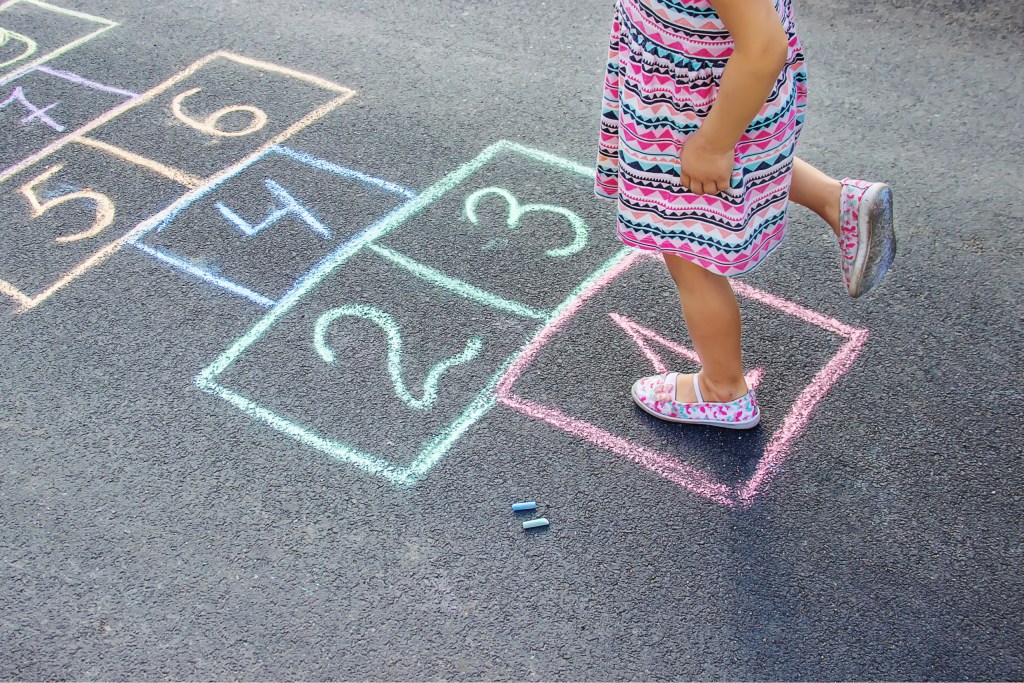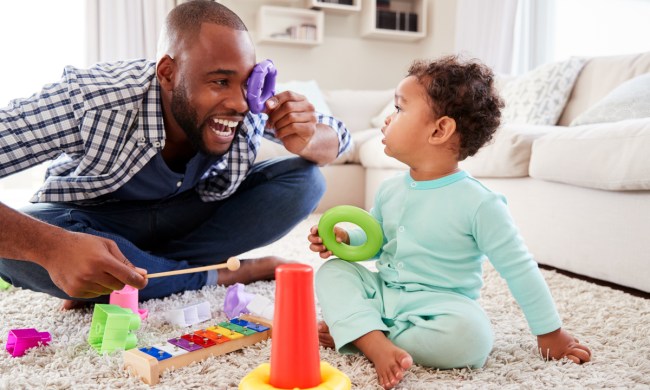
If it seems like hopscotch has been around for ages, it has. The classic game actually originated in Ancient Britain. A hopscotch board was used by Roman soldiers as a training exercise. Eventually, kids picked up on it, added some rules, and hopscotch was born. Today, hopscotch is still played on playgrounds, in schoolyards, and at home all over the globe.
The amazing thing about hopscotch is that it’s a perfect pick for kids of all ages, not to mention adults; just try walking past a hopscotch court without hopping through it. There are also cool variations of hopscotch kids can try, too, as well as creating their own version. Don’t worry if you’ve forgotten how to play hopscotch. We’ve got everything you need to know about hopscotch and more.
How to play hopscotch

One of the best things about hopscotch is that you can play the classic game solo or with a group. You can also play it pretty much anywhere. Hopscotch is of course fun, but playing the game also helps develop hand-eye coordination, balance, and leg muscles. It’s probably why it was used as a training exercise for soldiers. The rules of basic hopscotch are simple, but before you can start playing, you need to create a court.
Materials
All you need to play hopscotch is sidewalk chalk and a marker. A stone or a beanbag makes an ideal marker. Sidewalk chalk is perfect for creating a court on the driveway, sidewalk, or asphalt. For grass, duct tape works to make a court.
Making a hopscotch court
For a traditional hopscotch court, start by drawing three 12-by-12-inch squares stacked on top of each other. Label the first with a 1. Place a 2 in the next box and a 3 in the third. Next, draw two side-by-side squares above the 3 box, as if you were creating the letter T out of squares. Going from left to right, label the first box with a 4 and the other a 5.
Then, create a 6 box above the 4 and 5 boxes in line with the first three boxes. Next, draw a 7 and an 8 box the same way you did with 4 and 5. Above those two boxes, create a 9 box that lines up with the other single boxes. Finally, end the hopscotch court with a larger 10 circle. The 10 circle is the top of the hopscotch court with the one box being the start.
Another perk of hopscotch is the court can be as creative as you like. You can change the number and size of the boxes. Hopscotch courts can be simple or colorful. It’s totally up to the players. So, have fun with it.
Hopscotch rules
Once you finish making the court, now it’s time to play.
- Toss the marker into box 1, making sure it doesn’t land on the line or out of the box. If it does, you’ve lost your turn.
- Hop on one foot to box 2 and 3.
- Jump into box 4 and 5 with one foot in each.
- Hop on one foot into box 6.
- Jump into 7 and 8, landing with one foot in each.
- Use one foot to jump up into box 9.
- Jump into 10 with two feet.
- Turn around to face the hopscotch court and return the same way.
- When you get to the box with the marker, pick it up while still standing on one foot.
- Then, finish the course.
- If you’re successful, you remain in the game.
- The next player goes, following the same course.
- Once everyone has had a turn, the marker now gets tossed into box number 2.
The goal is to continue in the game until you’re tossing the marker into box 10 and returning to the start without a misstep. Players lose turns if they fall, miss a box without a marker, or can’t successfully pick up the marker while remaining on one foot. If you miss a turn, you must repeat the number you messed up on. The winner is the player who can get to 10 and back without missing a turn.
Hopscotch variations

While the classic game of hopscotch is always fun solo or with friends, there are variations to the game that are a blast, too. If the kids are looking for a twist on basic hopscotch, try these cool versions.
Timed hopscotch
To keep the game moving and add an element of speed, use a timer and give players 30 seconds to get through the course. For younger kids, you can stretch the time to 45 seconds or a minute. If time expires before the players get back to the start, they lose a turn.
Random tosses
Instead of going in numerical order, allow players to toss the marker wherever they want to. A player must announce the number prior to the start of the turn and can’t repeat any numbers. The winner is the first player to get to all 10 boxes without losing a turn.
Create larger and smaller boxes
To make the game more challenging, change the size of the boxes. Smaller boxes make it more difficult to avoid lines when throwing the marker and landing in the box. With different sized boxes, players will be off balance. This version is ideal for older kids. Younger ones need standard or slightly larger boxes. Another twist is to change the number of total boxes. Eight is popular for a hopscotch court, but you could do more than 10 or less.
Hop/kick
Another way to make the game a bit more difficult for players is to have participants kick the marker along the court in numerical order with their hopping foot. If players miss or slip, they lose a turn.
Category hopscotch
You can completely change the game by putting categories in each of the 10 boxes instead of numbers. Popular categories are streaming shows, books, food, pizza toppings, ice cream flavors, or ice cream toppings. When kids land in each box, they must shout out one thing from the category, like cookie dough for an ice cream flavor.
Hopscotch has definitely stood the test of time, and for good reason. It’s fun. Playing hopscotch is actually exercise, and a game kids of all ages can do. Even tweens and teens will take a turn on a hopscotch court and adults do, too. Doing so takes grownups back to those carefree childhood days. So, if your kids are bored, introduce them to hopscotch or one of its variations. On a rainy day, a hopscotch court can be created indoors if you have the space using masking tape.



